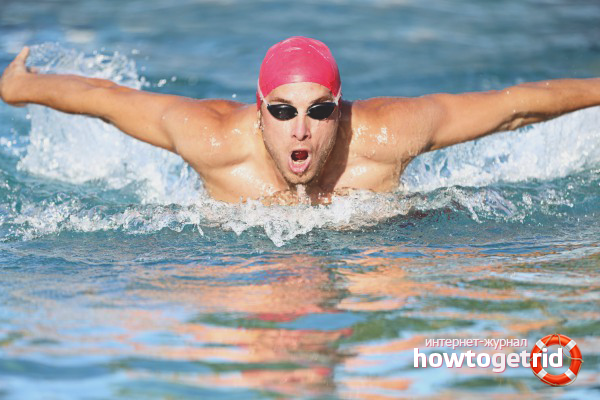The content of the article
A person knows what he needs from birth, for example, how to walk, talk and communicate with other people. But swimming in the modern world is not the most important property, so not all children at one time taught this ability. And now many adults find themselves in an uncomfortable position because they have to splash on the shore, instead of feeling this unique feeling - the conquest of the water surface.
You should not despair, because you can learn to swim at any age, the main thing is to overcome the fear of depth, if there is one. First of all, imagine how you enter the water, no, even jump into it with a run-up and swim with everyone or alone, enjoying the fact that you can now be in a certain weightlessness and at the same time be a conqueror of the water surface. Submitted? Now let's learn this art.
Training
For starters, it is better to choose a shallow pool. So, you will feel confident and completely safe, yet you will be followed by specially trained people and you can always control the presence of the bottom, unlike an unpredictable body of water. For this fit pools, where a shallow depth is the same throughout the pool. If you are confident in yourself, you can choose the paths where, when entering, the water level will be, for example, 1.2 meters, and at the end 2.5 meters.
If you have a fear of immersion in the water with your head, then first you should get swimming goggles, so in a well-viewed space, you can freely navigate in it and then you will not suffer panic. Then you should gradually dip into the water, each time increasing the time for which you can stay under water without risk to health.
Choose training time in the pool, when there are few people in it, because then you will not be disturbed when you reach your goal. It will also be helpful to hire a trainer, so you will significantly reduce the time for learning to swim, and get some useful tips from a professional.Moreover, an individual lesson involves a separate path, where you will feel even more confident.
Before exercising, it is necessary to warm up the muscles by doing a special warm-up, so the body will be prepared for an unusual load and the risk of physical injury will decrease.
To overcome fear and prepare for training, you need to psychologically tune in to such a test. You must convince yourself that water keeps your body afloat. This will help you to perform several effective exercises:
Go to the water to the waist, put your hands on the surface of the water and see how it keeps them afloat.
Exercise "float":
- go to the water to the waist or slightly higher;
- gather as much air as possible into the lungs;
- crouch down and clasp your legs;
- hold your nose to your knees.
After the water starts to push you, hold afloat as long as possible. Regularly performing this exercise on several approaches, you gradually teach to freely keep yourself in the water.
Slip in water:
- go into the water on the shoulders, while holding his hands to the body;
- immerse yourself in the whole hull and push your feet off the bottom;
- now everything follows with its body as if to glide on water, keeping itself in an absolutely straight position;
- having made several approaches, tear off the legs from the bottom and begin to chat with them, keeping the toes stretched out.
It may take considerable time and maximum patience to get results using this exercise.
Similarity breaststroke
- inhale;
- stretch your arms in front of you
- tilt your head straight into the water;
- make a light kick with your feet;
- move your arms to the side.
If you are covered with panic when water gets into your nose, then it will be very difficult to learn how to swim, because if you fear the pulse speeds up and your breath gets off. To accustom yourself to the water and stop being afraid, you need to perform an exercise that should be done in the pool. To do this, go into the water so that the legs do not touch the bottom, while holding the sides. Next, inhale, dive into the water, exhale and swim to the surface. Take a few approaches to get your mind used to this state.
Another good way to learn to swim is to use a special board or even a rubber circle like in childhood. Grab an object with your hands and swing your legs, feeling how easy you can manage your "transport".You can also lie on the board, then your arms and legs will be free, and you can train the movement technique, bringing it to perfection. Feeling your body and gaining confidence, try also to swim without the aid of any object. If you are frightened, then grasp the circle or the board again with your hands, making independent attempts each time. Let not immediately turn out, but still try, each time remaining alone with your body.
Swimming styles for beginners
After you have learned to float, you can begin to learn different styles of swimming. The following are the most common ways of swimming for those who have only grasped the ability to float:
- Like a dog. This is the easiest style of swimming. To the exercise “gliding on the water” we add movement with our hands, with which you alternately row by yourself. You need to move your hands calmly and rhythmically, without sharp jerks, otherwise you can quickly get exhausted from the habit. Keep your head high above the water. Breathing is also an important element, first taking a deep breath with a nose with inflating cheeks, holding the breath and exhaling through the mouth.Then you can move on to the movement of the legs, as frogs do: to push off from the water at the same time with both legs. Next, we change the direction of the hands, now they should be spread out to the sides, as if pushing water away;
- On the back. It is advisable to have a partner with you who will help you to float. To do this, lie on your back, immerse your head in the water, stretch your arms, relax and begin to breathe calmly. When you feel a certain weightlessness, start gradually moving your legs up and down;
- Crawl. This style is mainly used by athletes, as it allows you to quickly pick up speed. To do this, lying on your back, make circular movements with your hands, raking the water beneath you, while moving your legs up and down.
General recommendations
- Do not engage on a full stomach. After eating, it should take at least an hour, and after class it is better to eat after 2.5 hours.
- So that nothing would hinder you, to feel yourself in weightlessness on the water surface, you need to remove all the jewelry.
- It is better to learn to swim from 16 to 19. Because in the morning the body is not yet ready to perform unusual loads, especially if it is something new for it.
- Before you start to swim, you need to stretch and relax the body. It will also be nice to take a warm shower.
- If you want to quickly learn how to swim, then you should get serious about the matter and train at least 3 times a week for 1-2 hours.
To learn to swim, it is important to remember only one thing - do not be afraid of water. Fear makes the body constrained and only slows down the learning process. To be able to swim is an important part in life, because it can save you in unforeseen situations, and also brings a lot of pleasure that can not be compared with anything. Learn to swim, it's no more difficult than learning to ride a bike. It is worth learning once, and you will never unlearn it.
Video: how to quickly learn to swim













To send